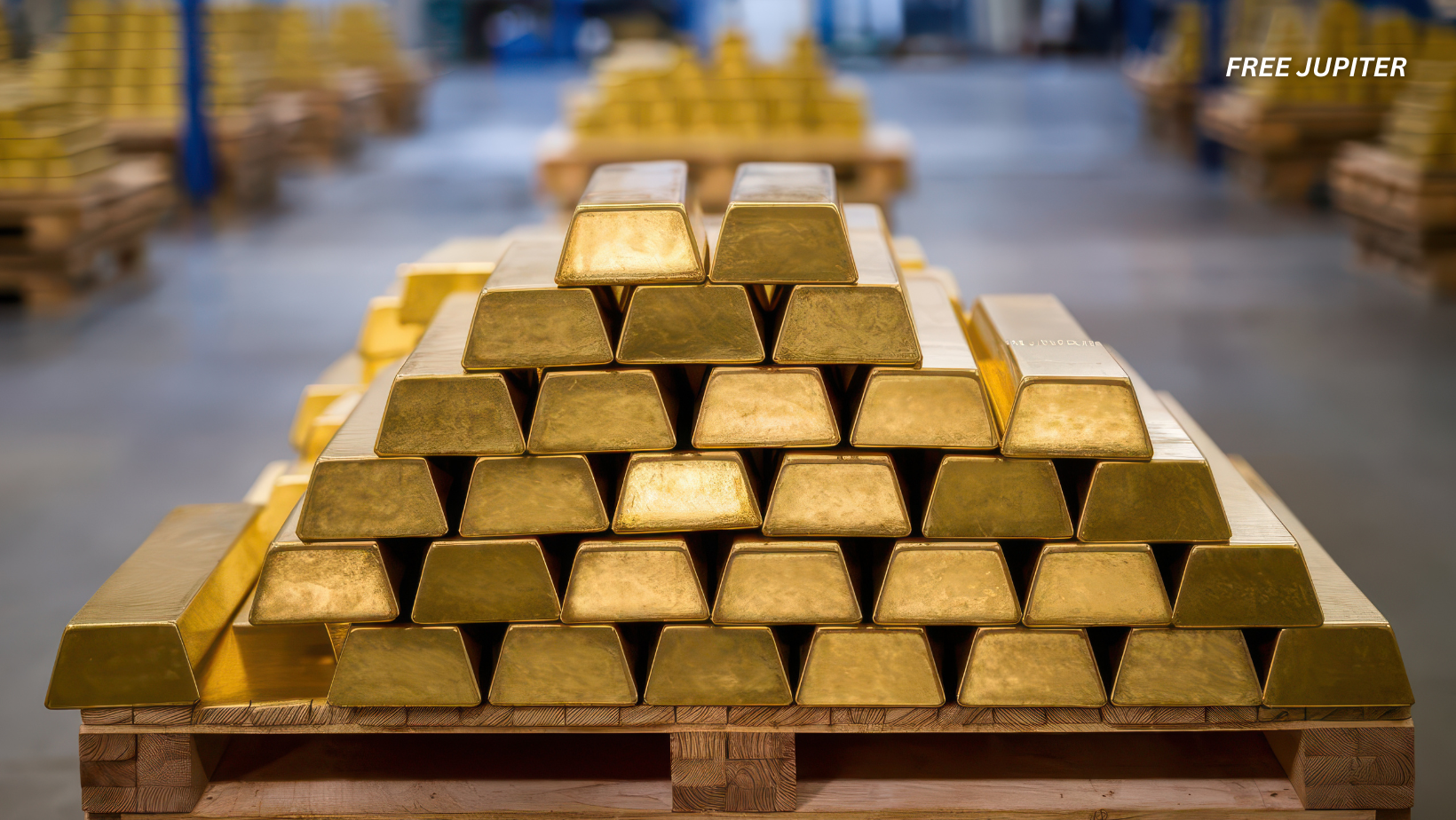Friendly Note: FreeJupiter.com shares general info for curious minds 🌟 Please fact-check all claims—and always check health matters with a professional 💙
Deep in the heart of China’s Hunan Province, a glittering secret has been unearthed. Geologists have announced the discovery of what is being described as a “supergiant” gold deposit, one so massive that its value has been estimated at nearly $100 billion.
This find, buried thousands of meters beneath the earth’s surface, is not only breathtaking in scale but also significant in timing. With global gold prices hovering near record highs, China’s discovery couldn’t have come at a more pivotal moment.
A Treasure Chamber Underground
The discovery lies in the Wangu goldfield, a site that had long intrigued geologists. After years of surveys, drilling, and modeling, experts confirmed that more than 40 ore veins snake their way through the rock. These veins have already yielded 300 tons of proven reserves, sitting around 2,000 meters deep—roughly the same height as two and a half Burj Khalifas stacked underground.
But here’s where things get even more dazzling: geological modeling suggests the true treasure could be over 1,000 tons of gold in total. If these projections hold, Wangu would rank among the largest gold deposits ever recorded.
The Price Tag of a Mountain’s Secret
At current valuations, the discovery is worth an estimated 600 billion yuan, or about $100 billion. That’s more than the annual GDP of countries like Slovakia or Sri Lanka, all contained within a single stretch of mountainside.
The timing couldn’t be better. Gold is considered a “safe haven” asset, which means its value often rises during times of economic uncertainty. With inflation concerns, shifting global trade dynamics, and unpredictable financial markets, investors worldwide have been pouring into gold. This has pushed prices close to record highs, making China’s discovery not just remarkable but also incredibly strategic.
Read more: The Discovery Of A 1,200-Year-Old Ship ‘Laden With Cargo’ Is Rewriting The History Books
China’s Long Relationship With Gold
China is no stranger to gold. The nation has been mining and trading the precious metal for thousands of years, stretching back to dynastic times when emperors demanded golden tributes and artisans shaped intricate ornaments for royalty.
In modern times, China has established itself as the world’s leading gold producer, surpassing traditional heavyweights like South Africa and Australia. The country consistently extracts over 300 tons of gold per year, and with the Wangu deposit now added to its reserves, that lead is expected to grow even larger.
For Beijing, this isn’t just about pride. Gold plays a crucial role in national financial security. China has been steadily increasing its gold reserves in recent years, using it to diversify away from foreign currencies like the U.S. dollar. A discovery of this size strengthens that strategy by ensuring a steady domestic supply.
Why Gold Still Glitters in a Digital Age
In an era where cryptocurrencies, electronic trading, and digital assets dominate headlines, gold might sound old-fashioned. Yet its value remains timeless. Why?
- Durability – Gold doesn’t rust, corrode, or decay. The same gold used in ancient coins could easily be melted and reused today.
- Scarcity – Unlike paper money, it can’t be printed on demand. Limited supply means its value is naturally preserved.
- Universal Appeal – From Tokyo to Timbuktu, gold carries prestige. It transcends culture, language, and borders.
Gold isn’t just for jewelry and investment. Its excellent conductivity makes it vital in electronics, space technology, and medical devices. So while investors may drool over its market value, scientists see it as an irreplaceable industrial resource.
Digging Deep: The Challenge of Mining at 2,000 Meters
Striking gold is one thing; getting it out of the ground is another. Mining at such extraordinary depths comes with formidable challenges.
- Heat & Pressure: At 2 kilometers underground, temperatures rise significantly, and pressure is intense. Specialized equipment is needed to protect workers and machines.
- Ventilation & Safety: Deep tunnels must be ventilated to prevent harmful gases from accumulating, and risks of rock bursts increase at these depths.
- Cost of Extraction: Digging deep veins is far more expensive than surface mining. Energy costs, drilling complexity, and safety measures add layers of financial investment.
Despite these hurdles, China’s experience as the top gold producer means it already has much of the expertise required. The Wangu project is likely to involve state-of-the-art mining systems designed to maximize yield while maintaining safety standards.
Read mor: Scientists Make Startling Discovery After Analyzing Cloth Jesus Was Buried In
Environmental Questions
Big discoveries often come with big environmental footprints. Mining can alter landscapes, pollute rivers, and disrupt ecosystems. In regions like Hunan, where agriculture thrives alongside rich biodiversity, this is no small concern.
China has pledged in recent years to prioritize “green development”, yet large-scale mining projects frequently spark debate. Supporters argue that strict regulations and modern technologies can minimize damage, while critics warn that the sheer scale of operations often overwhelms safeguards.
How China handles this discovery will be a test of whether economic ambition can coexist with environmental responsibility.
Ripple Effects in the Global Market
A gold discovery of this size doesn’t just matter for China—it matters for the world.
- Market Confidence: With China sitting on an even bigger pile of gold, investors may view the metal as more stable in the long run.
- Trade Dynamics: By securing more gold reserves, China strengthens its economic independence, reducing reliance on international markets.
- Geopolitics: Gold isn’t just an economic asset—it’s a political tool. Countries with large reserves often wield more influence in global negotiations.
While the Wangu deposit won’t flood the market overnight—extracting it will take years—it will shape investor sentiment and potentially influence how central banks worldwide approach their gold reserves.
Echoes of Gold Rushes Past
This discovery calls to mind history’s great gold rushes:
- California (1848): Sparked mass migration westward in the United States.
- South Africa (1886): Helped transform Johannesburg into a booming metropolis.
- Australia (1850s): Fueled waves of migration and economic development.
Each rush brought both prosperity and upheaval. While modern China won’t see pickaxe-wielding prospectors flooding Hunan, the echoes are there: whenever massive gold deposits are found, economies shift, cultures adapt, and the global balance of wealth tilts ever so slightly.
Gold’s Symbolism in Culture
Beyond economics, gold has always been drenched in symbolism. In Chinese tradition, gold represents prosperity, good fortune, and longevity. It is central to New Year celebrations, weddings, and gift-giving rituals.
This cultural resonance adds another layer to the discovery. It isn’t just a resource—it’s a symbol of national wealth and identity. Having a mountain filled with gold isn’t only about financial reserves; it’s about reinforcing a story that ties modern China to its ancient traditions.
What Happens Next?
For now, the Wangu deposit remains largely untouched. The next steps involve more intensive geological surveys, infrastructure planning, and eventually, large-scale extraction. This process could take years, if not decades, before the full bounty is realized.
Yet even at this early stage, the discovery has already reshaped conversations about gold in the 21st century. It serves as a reminder that despite satellites, supercomputers, and virtual assets, the earth still hides treasures of unimaginable scale.
Read more: Scientists Make Unexpected Discovery in Sea Otters—And Say It ‘Feels Like Renewed Hope’
Final Sparkle
China’s $100 billion gold discovery is more than just a shiny headline. It ties together history, culture, economics, environment, and even geopolitics. Gold has always fascinated humanity, and this latest find proves its story is far from over.
Somewhere beneath the mountains of Hunan, a glittering vault has been sitting quietly for millions of years. Now that it has been found, it may not only change China’s economic future but also leave its mark on the world.










